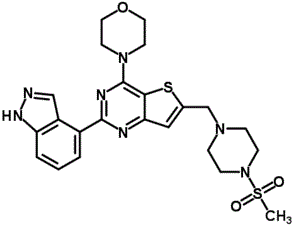| Cas No.: | 957054-30-7 |
| Chemical Name: | GDC-0941 (Pictilisib) |
| Synonyms: | GDC-0941,GDC 0941 |
| SMILES: | CS(=O)(=O)N1CCN(CC1)CC2=CC3=C(S2)C(=NC(=N3)C4=C5C=NNC5=CC=C4)N6CCOCC6 |
| Formula: | C23H27N7O3S2 |
| M.Wt: | 513.63 |
| Sotrage: | 2 years -20°C Powder, 2 weeks 4°C in DMSO, 6 months -80°C in DMSO |
| Description: | GDC-0941 (Pictilisib) is a potent inhibitor of PI3Kα/δ with an IC50 of 3 nM, with modest selectivity against p110β (11-fold) and p110γ (25-fold). |
| In Vivo: | GDC-0941 (150 mg/kg, p.o.) leads to tumor stasis in MCF7-neo/HER2-bearing animals model. GDC-0941 and docetaxel result in tumor regressions during the treatment period leading to enhanced antitumor responses[1]. Tumours in the GDC-0941-treated mice show a marked non-linear shrinkage, and when the GDC-0941 treatment ceased, the tumours in the test cohort mice grow again[2]. GDC-0941 (25 or 50 mg/kg) reduces tumor growth and PI3K and HIF-1 pathway activity in eGFP-FTC133 tumor-bearing mice[4]. |
| In Vitro: | GDC-0941 and docetaxel reduce tumor cell viability by 80% or greater in the breast cancer cell lines than single-agent treatment. GDC-0941 inhibits Akt phosphorylation and downstream targets of Akt signaling such as pPRAS40 and pS6 in Hs578T1.2 (PI3Kα wild-type), MCF7-neo/HER2 (PI3Kα-mutant), and MX-1 (PTEN-null) tumor models. GDC-0941 decreases the time of docetaxel-induced mitotic arrest prior to apoptosis[1]. GDC-0941 shows a high efficacy of antitumor activity in two gefitinib-resistant non-small cell lung cancer (NSCLC) cell lines, A549 and H460. GDC-0941 is highly efficacious in combination with U0126 in inducing cell growth inhibition, G0-G1 arrest and cell apoptosis. H460 cells with activating mutations of PIK3CA are relatively more sensitive to GDC-0941 than A549 cells with wild-type PIK3CA[3]. GDC-0941 reduces PI3K pathway activity in both cell lines, illustrated by decreased pAK. GDC-0941 significantly reduces secreted VEGF detected in the medium after hypoxic/anoxic exposure in all cells[4]. |

 DC Chemicals' products qualify for U.S. tariff exemptions. We guarantee no price increases due to customs duties and maintain stable supply, continuing to deliver reliable research solutions to our American clients.
DC Chemicals' products qualify for U.S. tariff exemptions. We guarantee no price increases due to customs duties and maintain stable supply, continuing to deliver reliable research solutions to our American clients.





















